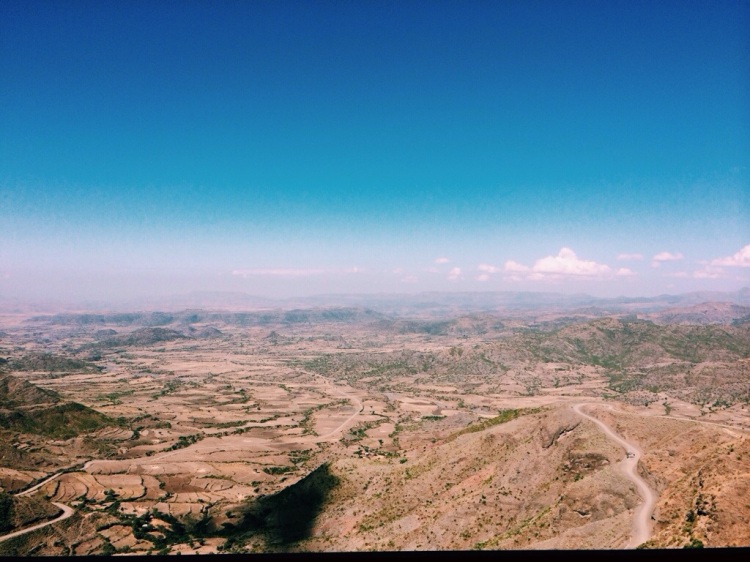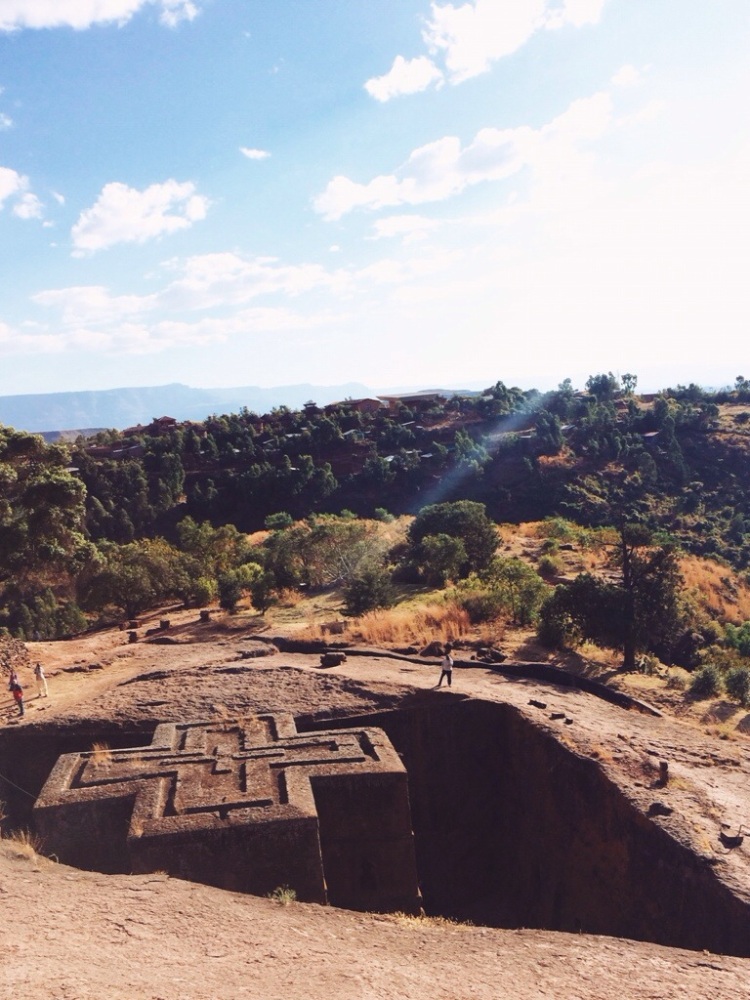
Not too long ago it would take you four days on a mule past the end of the road to reach Lalibela. Now, it’s a 45 minute plane ride from Addis. By land, it still takes two days if you take a bus, and from the air you can see why.

The landscape from the air of central Ethiopia is reminiscent of the Southwestern United States, but perhaps, even more dramatic. Leaving Addis, farms and villages stretch on the flat plains towards the horizon, dotted on asymmetric swatches of green and brown earth. Suddenly, enormous canyons appear everywhere. They are staggeringly deep, all with villages perched precariously on their edges overlooking, what must seem from their perspective, oblivion. It’s thought to be the result of tectonic plates. Though it looks distinctly like the earth was pelted by hundreds of asteroids.
Regardless, it is staggeringly beautiful. As a child of the 80’s where the only news of Ethiopia involved famine, I had no idea how much green there was in this country, or how starkly beautiful it would be.

Our hotel, top twelve, overlooks a smaller valley situated below the small town of Lalibela. We came here, as most visitors to the region, to see the famous churches. A recent entry cost hike has caused some tourists to skip it all together, and indeed, it isn’t cheap, even by western standards. But, given it’s the most visited site in the country, and it’s status as a UNESCO world heritage site, we opted to go anyway, despite the absurd $50/person fee. Luckily, we weren’t disappointed.

It’s dark in the tunnels beneath the churches. The sort of darkness that is all encompassing, disorienting. Our guide insisted it was better this way, to feel our way through the stone tunnel. And so we did, one hand above my head, in case the ceiling suddenly lowered, one hand guiding me along the smooth, cold wall. My fingers grazed the divots of the walls, my feet shuffling along, ears pierced to ensure I stayed with the guide. When the lights came back on I was further behind than I thought, as the tunnel amplified all sound. I quickened my pace to the end of what our guide told us, was symbolic of perdition. Now, he says, we climb the stairs to heaven, and the next church on our visit.

The scale of the churches is difficult to capture. They are rather large, and considering carved entirely out if the stone earth, extremely impressive. Just imagine standing on the ground, atop stone, and thinking, here I will dig down a dozen meters into the earth and carve out a church! 800 years ago, no less. The result, the worlds largest rock hewn church, though the most impressive, and most photographed is actually one of the smallest. The entire complex is meant to be a second Jerusalem for pilgrims, and as a result many of the names are symbolic representations of Jerusalem. On our second day we were able to watch chanters around one of the church, priests and students, cloaked in white read and chanted for hours providing the background for our second day of exploration.
We spent two half days exploring the various churches. Lalibela offers little else, aside from trekking, so we filled the rest of our time sipping coffee, fresh juice, or beer, reading, researching, and generally relaxing. We’ve spent three days here, and while it could certainly be done in one or two, we’re enjoying our slow paced travel.

Our last night, we ate dinner at Ben Abeba, pictured above, a strange architectural restaurant co-owned by a Scottish-Ethiopian duo. We arrived early to watch our last sunset in Lalibela, drink beer and stay warm by the fire. Despite the hot days, the nights are quite cold. We ate Doro Wat, a specialty of Ethiopia that is essentially stewed chicken in spicy sauce. Ethiopian food is something I’ve loved for years now, and is unlike any other African cuisine I’ve encountered (which is, generally, a good thing). Most importantly, it’s spicy. I love a culture that uses spice, and well. A delicious last experience before moving on to Gondar.
Was Lalibela worth it? Yes. Is it overpriced? Absolutely. Granted, we had an excellent guide arranged by out hotel who happened to also be a priest and extremely knowledgeable. Which can make or break the experience. Personally, I’m glad we did it.